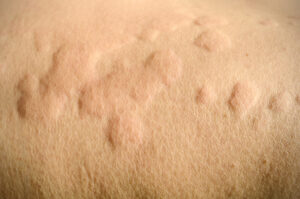April 03, 2023 | Black & Kletz Allergy

There are 2 basic criteria for hives. If one has hives on and off for less than 6 weeks, that person is said to have “acute” urticaria. If, however, the hives last 6 or more weeks, that individual is said to have “chronic” urticaria. Acute urticaria is more common than chronic urticaria and it is not uncommon. Approximately 20-25% of Americans will have hives at some point in their lives. Hives generally last less than 24 hours, but may last longer. They may occur very frequently (i.e., multiple times a day) or occur very rarely, (i.e., one isolated episode). Hives tend to be intermittent (i.e., come and go) as opposed to remaining on the skin for days, weeks, or months like eczema (i.e., atopic dermatitis). Chronic urticaria acts the same as acute urticaria except that the duration of the hives is 6 weeks or greater.
There are many causes of hives. Some of the common causes of hives may include an allergy to a food (e.g., peanuts, tree nuts, milk, egg, soy, wheat, fish, shellfish), medication [e.g., antibiotic, aspirin, nonsteroidal anti-inflammatory drugs (ibuprofen (Advil, Motrin), naproxen (Naprosyn, Aleve, Anaprox), indomethacin (Indocin), salsalate (Disalcid), diclofenac (Arthrotec, Voltaren, Cataflam), ketorolac (Toradol), celecoxib (Celebrex), meloxicam (Mobic), nabumetone (Relafen), tolmetin (Tolectin), fenoprofen (Asaid), etodolac (Lodine), sulindac (Clinoril), piroxicam (Feldene), and oxaprozin (Daypro)], or flying insect sting (e.g., bee sting). Other common causes may include an infection (i.e., viral, bacterial, fungal, or parasitic), autoimmune disorders (i.e., the immune system fights against an individual’s body instead of fighting against outside invaders), inflammatory conditions (i.e., vasculitis), and/or rarely cancers. In addition to the forementioned causes, physical stimuli such as heat, cold, exercise, pressure, vibration, sun exposure, and/or even water exposure can cause hives in sensitive individuals.
If someone has chronic urticaria, it is important to find out if there is an underlying condition present that is causing that individual to have the hives. The diagnosis of hives begins with a comprehensive history and physical examination. Allergy skin testing or blood testing may be needed depending on the patient’s unique situation with respect to their hives. For patients with chronic urticaria, blood testing and a urinalysis are obtained in order to look for an underlying condition that may be causing the hives. It is interesting to note that despite doing a thorough workup for chronic urticaria with blood and urine tests, 95% of the time no cause is identified. In these cases, the chronic urticaria is designated as “idiopathic” which is basically saying that we know what is not causing the hives, but we still do not know what is causing them. These patients are labeled as having chronic idiopathic urticaria (CIU) or chronic spontaneous urticaria (CSU).
The treatment of hives usually begins with oral antihistamines or H1 blockers [e.g., Claritin (loratadine), Allegra (fexofenadine), Zyrtec (cetirizine), Xyzal (levocetirizine)]. In some cases, H2 blockers such as Pepcid (famotidine) may be used in combination with the H1 blocker (antihistamine). Leukotriene antagonists [e.g., Singulair (monteleukast)] may also be used if needed. Occasionally corticosteroids may be necessary to treat recalcitrant cases. In addition to the above medications, patients with chronic spontaneous urticaria (i.e., chronic idiopathic urticaria) may benefit greatly with Xolair (omalizumab), a biologic injectable medication which is usually administered monthly.
There are 2 other conditions that are related to hives that should be discussed since they can occur without hives or with hives. They are as follows:
Pruritus: Even though pruritus technically means “to itch,” it should be noted that some individuals just itch without having associated hives while as mentioned above, some itch with associated hives. For the purposes of this blog, pruritus means the former, itching without hives or a rash. The diagnosis and management are essentially the same as with hives except Xolair is not used in patients with just pruritus alone.
Swelling (i.e., angioedema): Similar to pruritus, swelling (i.e., angioedema) may occur simultaneously with hives or the swelling can occur without associated hives. One can think of angioedema as a large hive, so in essence it is not really different from a hive, except it can be scarier to the individual with the swelling. Of course if the swelling is in the throat for example, it can be life-threatening. The diagnosis and treatment are also basically the same as with hives except there is an added blood test (i.e., C1 esterase inhibitor level) that is obtained and like with the treatment of pruritus, Xolair is not used with just angioedema alone.
The board certified allergy doctors at Black & Kletz Allergy located in the Washington, DC, Northern Virginia, and Maryland metropolitan area will readily answer any questions you have regarding hives (i.e., urticarial), itching (i.e., pruritus), swelling (i.e., angioedema) or any other allergic condition. We have 3 offices with locations in Washington, DC, McLean, VA (Tysons Corner, VA), and Manassas, VA. All of our offices offer on-site parking. In addition, the Washington, DC and McLean, VA offices are accessible by Metro. There is also a free shuttle that runs between the McLean, VA office and the Spring Hill metro station on the silver line. Please make an appointment by calling any one of our 3 offices, or alternatively, you can click Request an Appointment and we will answer you within 24 hours by the next business day. Black & Kletz Allergy diagnoses and treats both children and adults and we are proud to serve the Washington, DC metro area residents for which we have done for more than 5 decades.












